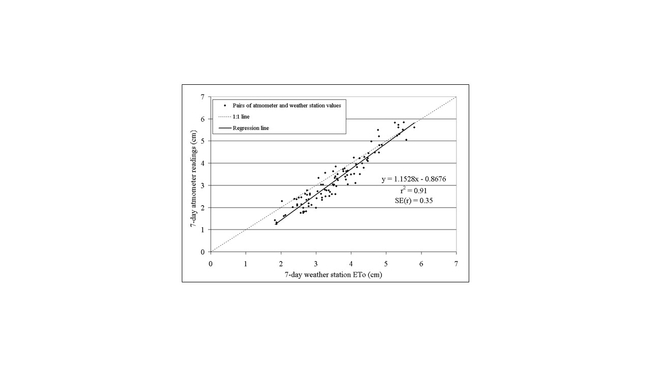
Irrigating with an Atmometer?
Say what? Atmosphere meters can be used to assess irrigation requirement. Here's a great little report from Mark Battany, our advisor in Santa Barbara and San Luis Obispo Counties.
ATMOMETERS FOR IRRIGATION MANAGEMENT
- Author: Mark Battany
Efficient and precise irrigation management is becoming increasingly important inCaliforniaagriculture, both for maximizing crop quality and for conserving water. The most advanced irrigation scheduling strategy is based on local measurements of reference evapotranspiration (ETo), which is converted to crop evapotranspiration (ETc) with an appropriate crop coefficient (kc).
To be able to use this method, an irrigation manager needs to have locally accurate ETo values throughout the growing season. However, the highly variable microclimates that characterize many farming areas often make it difficult to use data from distant weather stations; therefore an accurate local measurement may often be preferable to relying on a regional value.
One inexpensive option for measuring ETo locally is to use a simple atmometer. Atmometers are water-filled devices, in which the actual evaporation of water is measured over time. In their simplest form, the atmometer is outfitted with a graduated sight glass on the water supply tank which allows the user to easily measure the evaporation that occurred over a given period. In practice, this type of atmometer is most suited for making readings at multiple day intervals, for example once per week, or on days when irrigation is applied.
The performance of atmometers versus more expensive weather stations was evaluated on the CentralCoastin 2003. In this study, atmometers were placed adjacent to seven weather stations throughout the area, and weekly values for both methods were compared. The results indicate that the atmometers and weather stations have very comparable ETo readings, with the atmometers indicating somewhat lower ETo values under conditions of lower evapotranspiration.
Like any technique, using atmometers has advantages and disadvantages. Advantages include their very low cost and ease of operation, with no computer or power required. Disadvantages include the potential for damage by freezing weather, the need to refill the water supply (every three to six weeks), and the need to read the gauge manually. Also, if they are installed in a large open area, birds may tend to perch on the evaporating surface and foul it with their droppings; for this reason several wires are installed on top of the device to discourage birds from perching there. In general, atmometers function quite reliably with few problems.
Converting atmometer ETo readings to the amount of irrigation run time required to replenish the soil moisture lost to evapotranspiration is fairly straightforward. A relatively simple example for a sprinkler-irrigated field is presented below in Table 1.
|
Table 1. Example conversion of ETo to irrigation run times for a sprinkler irrigated field |
||
|
|
|
|
|
A. Measured atmometer ETo for one week |
2 |
inches |
|
B. Crop coefficient (kc) |
0.8 |
|
|
C. Calculated ETc for the week (=AxB) |
1.6 |
inches |
|
D. Sprinkler application rate |
0.13 |
in/hr |
|
E. Hours of irrigation required (=C/D) |
12.3 |
hours |
(Note: To convert Gallons to Inches: Gallons ÷ Area (square feet) ÷ 0.6234 = Inches. To convert Inches to Gallons: Inches * Area (square feet) ÷ 1.604 = Gallons)
Regression table showing relationshiop between CIMIS weather station and atmometer
Atmometer in the field

atmometer grapes


Posted by Greg Alder on June 18, 2018 at 9:00 PM